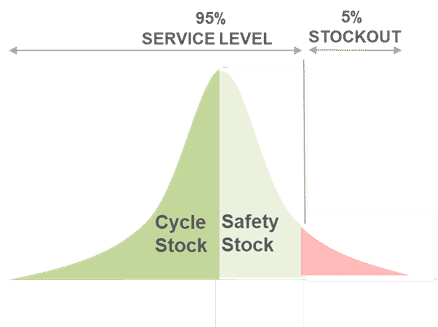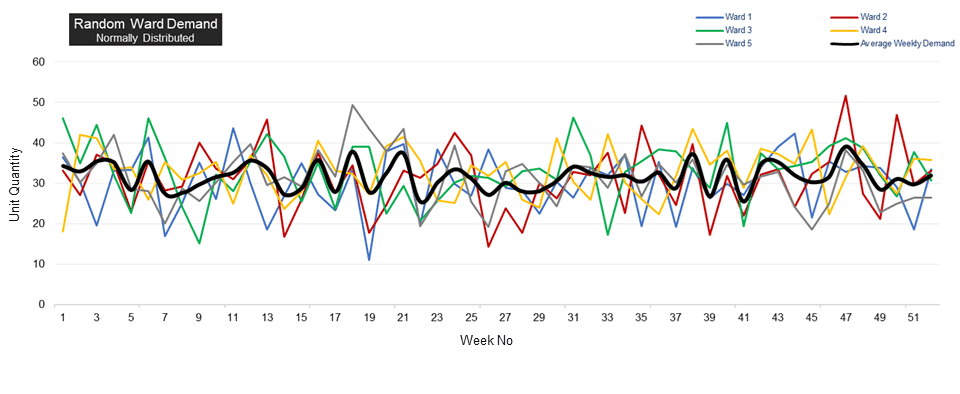Stock management and control is complicated by the presence of uncertainties in demand and the lead time, and most of the time, in the execution of replenishment tasks itself. The most pervasive factor influencing uncertainty in the supply chain is variability (complexity, and constraints also play a role) and its effects can propagate and magnify across the entire supply chain spectrum. On the upstream-side, uncertainty can lead to disruptions, shortfalls and delays, while downstream, the causes of demand variability generally result from inherent qualities of the business and its customer base, or from external factors.
In situations where the supply chain is disrupted (i.e., supply and demand do not match), inventory can be used as a powerful tool to mitigate uncertainty. In particular, we generally introduce Safety Stock to absorb volatility and avoid the consequences of stocking out.
Another risk-protection strategy is Pooling, which allows us to combine multiple sources of variability. This has the effect of reducing the coefficient of demand variation which ultimately leads to a reduction in the level of stock required to deliver the same service performance.
Let us now review both strategies.
- Safety Stock
Often, we are faced with demand that is probabilistic; so there’s a chance we won’t be able to satisfy some of our customer requirements directly from stock.
Now, safety stock is sometimes considered a “necessary liability”; however, provided overstocking is avoided, it can be easily treated as an asset and to do so, it is essential to define its ideal level. Occasionally, some managers prefer to set levels using informal decision rules and, although easy to execute, this generally results in poor performance in the long-run. Instead, we recommend undertaking a data-driven approach to stock management – to help balance customer service performance and inventory costs.
We sometimes forget that safety stock cannot fully prevent stockouts – only the majority of them. For example, in planning for a 95% service level, expect that, in approximately 5 percent of replenishment cycles, it is not possible to respond to demand with stock on-hand (Fig 1).

In the end, however, safety stock is an effective way to mitigate demand uncertainty and lead time variability but only if the replenishment levels are optimally set; one effective way to accomplish this is to first categorise your demand patterns.
- Demand Classification
basically helps us assess the level of randomness in demand quantity and timing. In most cases, ordering decisions are made at the item or SKU level and it is now widely accepted that each SKU has its own underlying demand behaviour which can significantly influence both inventory and service. The principle is simple; highly-variable items can be treated in a different way to those that are less variable in volume and time, and this permits us to match a SKU to a particular planning model.
Consequently, this can drive stock levels down significantly and in the process, reduce your working capital and associated expenses including storage, handling, and holding costs. Of course, in the process, service performance can be protected and many cases, improved!
- Risk Pooling
is another powerful way to mitigate demand uncertainty.
This concept states that, under certain conditions, the aggregation of demand streams diminish variability and in effect, reduce the quantity of safety stock required to service demand. Essentially, this works because the sum of random variables has a lower level of uncertainty than that of the individual random variables. In fact, in merging all demand streams, much of the aggregated variability will average-out to give a skinnier distribution of lead time demand and if properly applied, can lead to less risk, lower safety stock levels and ultimately, reduced holding costs.
Interestingly, demand streams don’t need to be separated in the true geographic sense. Pooling benefits can be derived at the departmental level and in fact, even within the same facility.
Take for instance, replenishment of consumable items in a hospital building. Hospitals are also plagued by uncertainties, and they struggle with demand variability from the patient side and supply uncertainty from the sourcing side and so, risk pooling methods can be applied in the healthcare context to reduce working capital and deliver patient care.
In comparison to manufacturing and fulfilment firms, hospitals often neglect the beneficial effects of risk pooling as each department replenishes stock independently; stock that is common to say, multiple wards within the same hospital building. By exploiting the variability-reducing effect of pooling, demand uncertainty can be suppressed (Fig 2) and inventory spend can be improved while providing the necessary hospital-wide patient service.

Of course, the application of risk pooling requires other factors to be taken into account; for example, as stock moves further away from demand, the resulting physical separation between inventory and customer may require consideration.
I trust you can appreciate how supply chain uncertainties can be relieved by using the proper replenishment model and by exploiting demand aggregation and in the end, reduce working capital.
If you wish to explore risk protection strategies further, contact us to discuss your specific supply chain requirements.
Supply Chain Enabled
